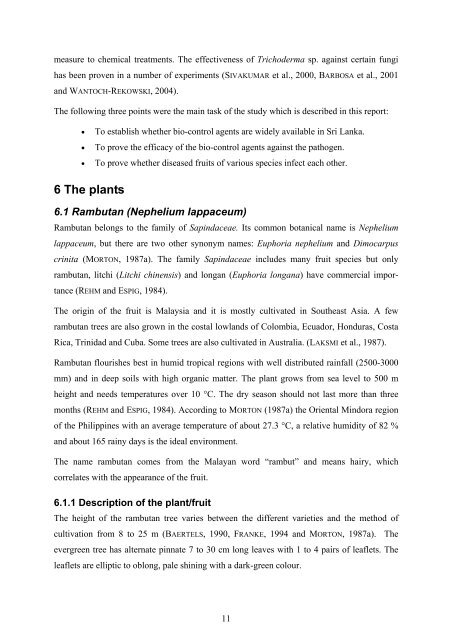Botryodiplodia sp. - Crops for the Future
Botryodiplodia sp. - Crops for the Future
Botryodiplodia sp. - Crops for the Future
You also want an ePaper? Increase the reach of your titles
YUMPU automatically turns print PDFs into web optimized ePapers that Google loves.
measure to chemical treatments. The effectiveness of Trichoderma <strong>sp</strong>. against certain fungi<br />
has been proven in a number of experiments (SIVAKUMAR et al., 2000, BARBOSA et al., 2001<br />
and WANTOCH-REKOWSKI, 2004).<br />
The following three points were <strong>the</strong> main task of <strong>the</strong> study which is described in this report:<br />
• To establish whe<strong>the</strong>r bio-control agents are widely available in Sri Lanka.<br />
• To prove <strong>the</strong> efficacy of <strong>the</strong> bio-control agents against <strong>the</strong> pathogen.<br />
• To prove whe<strong>the</strong>r diseased fruits of various <strong>sp</strong>ecies infect each o<strong>the</strong>r.<br />
6 The plants<br />
6.1 Rambutan (Nephelium lappaceum)<br />
Rambutan belongs to <strong>the</strong> family of Sapindaceae. Its common botanical name is Nephelium<br />
lappaceum, but <strong>the</strong>re are two o<strong>the</strong>r synonym names: Euphoria nephelium and Dimocarpus<br />
crinita (MORTON, 1987a). The family Sapindaceae includes many fruit <strong>sp</strong>ecies but only<br />
rambutan, litchi (Litchi chinensis) and longan (Euphoria longana) have commercial importance<br />
(REHM and ESPIG, 1984).<br />
The origin of <strong>the</strong> fruit is Malaysia and it is mostly cultivated in Sou<strong>the</strong>ast Asia. A few<br />
rambutan trees are also grown in <strong>the</strong> costal lowlands of Colombia, Ecuador, Honduras, Costa<br />
Rica, Trinidad and Cuba. Some trees are also cultivated in Australia. (LAKSMI et al., 1987).<br />
Rambutan flourishes best in humid tropical regions with well distributed rainfall (2500-3000<br />
mm) and in deep soils with high organic matter. The plant grows from sea level to 500 m<br />
height and needs temperatures over 10 °C. The dry season should not last more than three<br />
months (REHM and ESPIG, 1984). According to MORTON (1987a) <strong>the</strong> Oriental Mindora region<br />
of <strong>the</strong> Philippines with an average temperature of about 27.3 °C, a relative humidity of 82 %<br />
and about 165 rainy days is <strong>the</strong> ideal environment.<br />
The name rambutan comes from <strong>the</strong> Malayan word “rambut” and means hairy, which<br />
correlates with <strong>the</strong> appearance of <strong>the</strong> fruit.<br />
6.1.1 Description of <strong>the</strong> plant/fruit<br />
The height of <strong>the</strong> rambutan tree varies between <strong>the</strong> different varieties and <strong>the</strong> method of<br />
cultivation from 8 to 25 m (BAERTELS, 1990, FRANKE, 1994 and MORTON, 1987a). The<br />
evergreen tree has alternate pinnate 7 to 30 cm long leaves with 1 to 4 pairs of leaflets. The<br />
leaflets are elliptic to oblong, pale shining with a dark-green colour.<br />
11

















